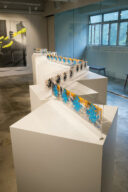Chronophotography
2023–, 2.5D(StareReap) print on acrylic board, 19.5 x 69.5cm / whole by 9 pieces, 36 images 19.5 x 625.5cm
« Chronophotography » or » Sequence Photography « , reminds me of the passionate research of the French physiologist Étienne-Jules Marey (1830 -1904). Among his inventions, the chronophotographic gun he created in 1882, which was designed to capture moving images, is particularly unique. Today, photographers call the act of taking pictures « shooting”. Ultimately, he was interested in the movements of humans, animals, insects, etc., and the purpose of his numerous inventions was to further deepen observation by deconstructing and visualizing movements. However, the titles of his researches, such as La Machine animale (The animal machine), chaussures exploratrices (explorer shoes), are so unique that they remind us of science fiction novels. This kind of integration of physiological research and photographic technology may have created the bizarre sci-fi like titles.
In 1902, which is a little later than the invention by Marey, a large airship with a length of 30m crashed on a street corner in Paris.
It happened near the intersection of Avenue du Maine and Rue de la Gaîté which is not far away from my studio. The airship “PAX” departed from the suburbs of Paris for its test flight, but suddenly its gas caught fire and the airship became uncontrollable. Then it crashed into the pavement, killing two brave challengers: the inventor Auguste Severo and the engineer Georges Saché. I decided to capture the streets where the crash happened as a series of photographs. Unlike Marey’s works in which the subject moves, I myself move and take pictures. Of course, there doesn’t seem to be any vestiges of the time when the airship crashed on that street, but even so, I tried to move slowly towards the point where it crashed. I clicked the shutter at a certain point, then moved the distance I set by myself and clicked the shutter again. I repeated the same movement and ended when 36 shots were taken. As I do the shooting, I started to create the objects imagining the impact of accident if I had witnessed the crash of the airship.
From here on, it becomes a freewheeling creation that is far from Marey’s serious research. Related to the airship that floats in the sky, I used the bones of the flying birds as the material. The flying bird was something the airship inventor dreamed of. The object begins with a single bird bone. As I added the bones one by one, I photographed it. It changes little by little, and it becomes a complicated object in the end. During this creative process, I was conscious of the movement. While the movement captured by Marey is the unshakable movement of reality, my movement was a creation which emerges from my physicality.
I wanted to create a work which combine the era and esprit in the 19th and early 20th century when these inventions and events emerged such as photography, animal machines, sequence photography, animation, balloons, airships, etc. Therefore, even though this series was shot with a digital camera and finished with 2.5D print, which is Ricoh’s latest technology, some processes simulate past technology. For example, as the negatives are opposed to positives, the street corner scenes are all negatives with the gradation reversed from reality. I also reversed the landscape from left to right as if I had seen it in a mirror. It’s a parallel world that’s a little off from reality. I believe that this phenomenon of reversal is the core of past photographic technology. In digital technology, there is no reversal in the process of creating a photograph, but once you step into the town, you will see reversal of left and right in the reflection of every window. The number of 36 shots is also a meaningless number for a digital camera. In this series, 2.5D is printed on a transparent acrylic plate. In the conventional ink jet printing, it is not possible to fix the images on this kind of smooth material as the ink is running. 2.5D print made it possible to harden the ink by projecting ultraviolet rays.
Thirty-six images fixed on a transparent acrylic plate which passes the lights are lined up. The light slightly passes through the image part, representing the reality which is hanging in midair like a negative film. I want you to imagine this, the gradation of the main blue object in the image is also reversed, so the object I made was actually orange like a burning flame.
Yuki Onodera 20 April 2023












